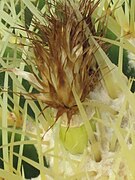Kroenleinia grusonii: Difference between revisions
Harrumphings (talk | contribs) m Removed double spaces |
ShortDescBot (talk | contribs) ShortDescBot adding short description "Species of cactus" |
||
| Line 1: | Line 1: | ||
{{Short description|Species of cactus}} |
|||
{{More citations needed|date=January 2017}} |
{{More citations needed|date=January 2017}} |
||
{{Italic title}} |
{{Italic title}} |
||
Revision as of 21:29, 8 March 2021
This article needs additional citations for verification. (January 2017) |
| Echinocactus grusonii | |
|---|---|

| |
| Echinocactus grusonii in a cactus collection | |
| Scientific classification | |
| Kingdom: | |
| (unranked): | |
| (unranked): | |
| (unranked): | |
| Order: | |
| Family: | |
| Subfamily: | |
| Tribe: | |
| Genus: | |
| Species: | E. grusonii
|
| Binomial name | |
| Echinocactus grusonii | |
Echinocactus grusonii, popularly known as the golden barrel cactus, golden ball or mother-in-law's cushion, is a well known species of cactus, and is endemic to east-central Mexico.
It is rare and endangered in the wild, where it is found near Mesa de León in the state of Querétaro, and in the state of Hidalgo.[1] The population was critically reduced in the 1990s, by the creation of the Zimapán Dam and reservoir in Hidalgo.[1] The cactus grows in volcanic rock on slopes, at altitudes around 1,400 metres (4,600 ft).[1]
Taxonomy
Echinocactus grusonii belongs to the small genus Echinocactus, which together with the related genus Ferocactus, are commonly referred to as barrel cacti. The species was first described by German plantsman Heinrich Hildmann in 1891. While sometimes referred to as golden ball, this species is not to be confused with Notocactus leninghausii which have fuzzy, harmless spines and are native to Brazil and Paraguay.
Description
Growing as a large roughly spherical globe, Echinocactus grusonii may eventually reach over 1 metre (3.3 ft) in height after many years. Younger Golden Barrel plants do not look similar to mature specimens. The generation lifetime is estimated to be 30 years.[1]
There may be up to 35 pronounced ribs in mature plants, though they are not evident in young plants, which may have a knobbly appearance. The sharp spines are long, straight or slightly curved, and various shades of yellow or, occasionally, white.
Small yellow flowers appear in summer around the crown of the plant, but only after twenty years or so.
Cultivation

Echinocactus grusonii is widely cultivated by specialty plant nurseries as an ornamental plant, for planting in containers, desert habitat gardens, rock gardens, and in conservatories.[2] A white-spined form, and a short-spined form, are also in cultivation.
It is one of the most popular cacti in cultivation and has increasingly become popular as an architectural accent plant in contemporary garden designs.[citation needed]
The cactus is considered easy and relatively fast growing in warmer climates around the world. The plants do have some basic requirements; an average minimum winter temperature of 12 °C (53.6 °F); and good drainage with less watering in winter.[2] Excess water in cool periods may lead to rot. Golden Barrels are hardy to about −8 °C (15 °F) for brief periods.
Beyond Central Mexico, Echinocactus grusonii specimens may also be seen in collections of desert plants in many botanical gardens. In the UK it has gained the Royal Horticultural Society’s Award of Garden Merit.[3][4]
Gallery
-
Mature golden barrels showing their distinctive clustering habit. Photo from the Huntington Desert Garden in California.
-
Closeup of the top.
-
Echinocactus grusonii, a nearly spineless form
-
Echinocactus grusonii spine detail at the United States Botanic Gardens
-
Stereoscopic crossview of a golden barrel cactus.
-
Spine detail
-
Flower detail
-
Fruit detail
-
Seeds
See also
References
- ^ a b c d IUCN: Echinocactus grusonii . accessed 6.3-.2013
- ^ a b [1] Archived 2013-01-04 at the Wayback Machine . accessed 6.30.2013
- ^ "RHS Plantfinder - Echinocactus grusonii". Retrieved 12 January 2018.
- ^ "AGM Plants - Ornamental" (PDF). Royal Horticultural Society. July 2017. p. 33. Retrieved 14 February 2018.
- Fitz Maurice, W. A. & Fitz Maurice, B. (2002). "Echinocactus grusonii". IUCN Red List of Threatened Species. 2002. Retrieved 4 November 2006.
{{cite journal}}: Invalid|ref=harv(help) - Preston-Mafham, Rod & Ken (1992). Cacti: The Illustrated Dictionary. Blandford Press. ISBN 978-0-7137-2092-1.
External links
dunu










